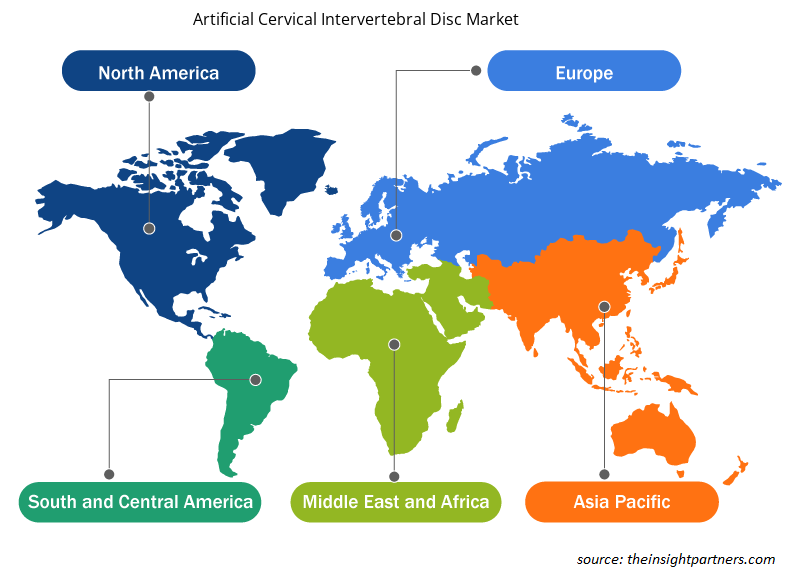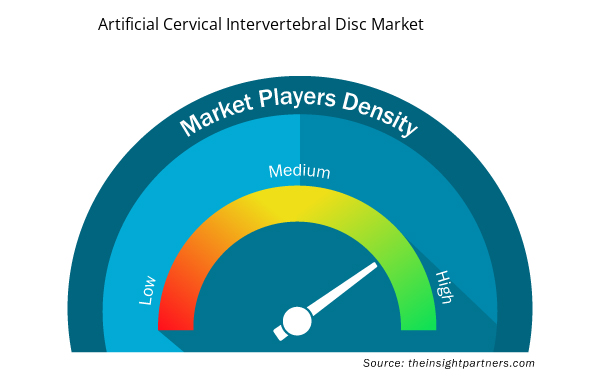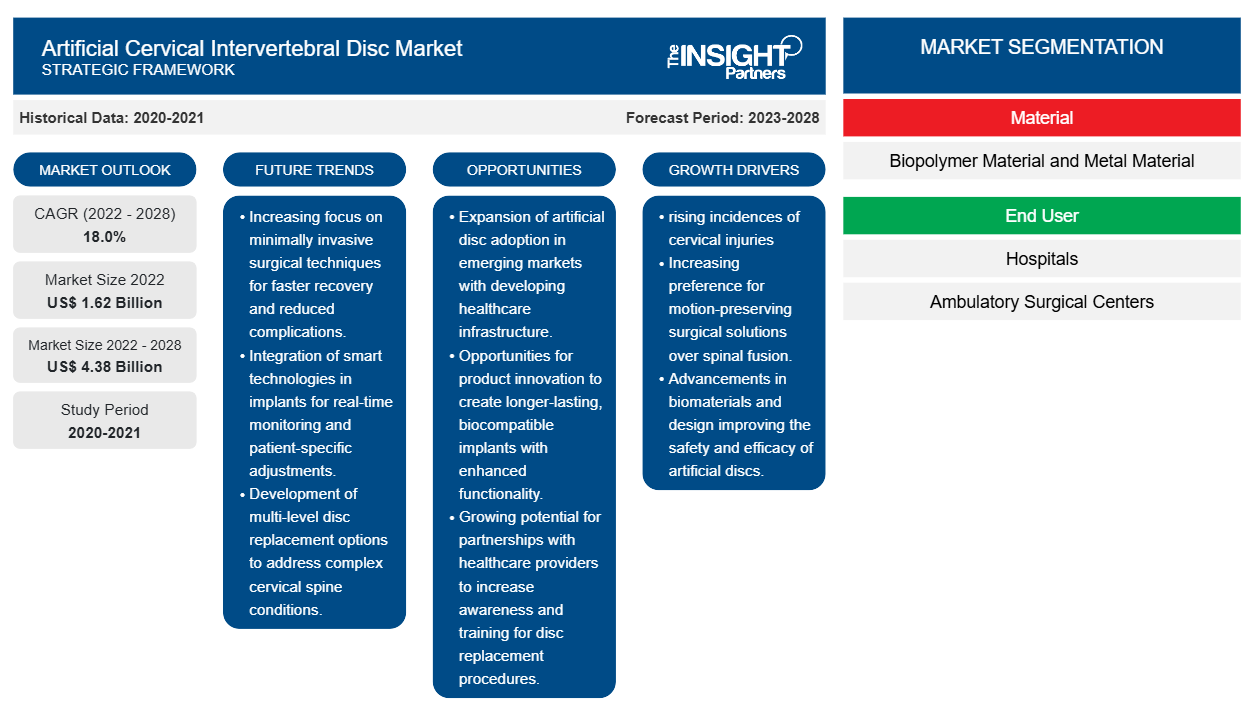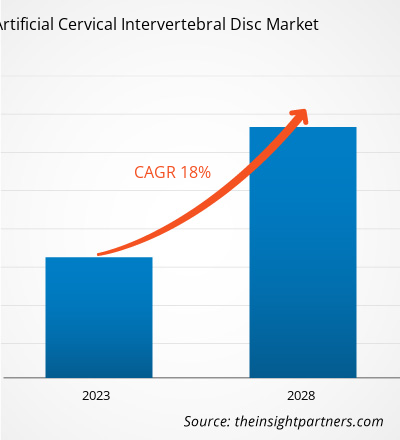[研究报告]人工颈椎间盘市场规模预计将从2022年的16.2166亿美元增长到2028年的43.7529亿美元;预计2022年至2028年的复合年增长率为18.0%。
人工颈椎间盘市场的增长归因于颈椎损伤患病率的上升。创伤是造成颈椎损伤的主要原因,包括车祸、穿透性或钝性创伤、跌倒以及运动或跳水损伤。根据 2020 年发表的《估计美国交通事故相关颈椎损伤数量:全国事故和医院数据的分析与比较》研究,在美国,医院每年观察到约 869,000 例交通事故相关颈椎损伤,其中约 841,000 例为扭伤/拉伤(挥鞭伤),2,800 例为椎间盘损伤,23,500 例为骨折,2,800 例为脊髓损伤,1,500 例为脱臼。此外,大多数运动损伤都是骨科损伤,包括拉伤、扭伤、骨折、韧带断裂、疼痛和肿胀;这些可能是急性或慢性的。根据斯坦福儿童健康中心的数据,美国每年约有 3000 万青少年和儿童参加体育运动,每年报告的运动相关伤害超过 350 万起。颈椎骨折是由高能量创伤造成的,例如体操、曲棍球、足球或跳水时的跌倒。运动员的骨折发生率很高。根据《2020 年脊髓损伤事实和数据一览》,在美国,大约 7.8% 的脊髓损伤 (SCI) 是由运动引起的。根据美国消费者产品安全委员会 (CPSC) 的数据,2018 年,美国医院急诊室治疗了约 23,720 例颈部骨折;其中约 3,194 例骨折是由运动引起的。随着全世界越来越注重健康生活,人们参与体育运动和积极参与健身活动的人数激增,运动损伤的发生率也随之增加。此外,根据美国国家脊髓损伤统计中心的数据,跳水是导致严重颈椎脊髓损伤的第五大原因。因此,由于颈椎损伤发生率不断上升,对人工颈椎间盘的需求也在不断增加。
颈椎间盘能够吸收巨大的压缩负荷,同时在颈部骨骼之间提供不同类型的运动。市场参与者已经开发出几种用于治疗颈椎间盘问题的人工颈椎间盘。人工颈椎间盘取代了受损颈椎间盘的运动和缓冲功能。
定制此报告以满足您的需求
您可以免费定制任何报告,包括本报告的部分内容、国家级分析、Excel 数据包,以及为初创企业和大学提供优惠和折扣
- 获取此报告的关键市场趋势。这个免费样品将包括数据分析,从市场趋势到估计和预测。
市场洞察
老年人口增长推动人工颈椎间盘市场
衰老过程会影响颈椎、颈部、肩部、上背部和手臂。颈椎病是指颈部椎间盘因年龄相关而磨损。这是一种常见疾病,随着年龄增长而恶化。根据美国骨科医师学会的数据,60 岁以上的人中约有 85% 患有颈椎病。随着年龄的增长,作为减震器的椎间盘会逐渐变干并影响强度。根据《美国老龄化情况说明书》,到 2060 年,65 岁及以上人口的数量预计将从 2018 年的 5200 万增至约 9500 万,其在总人口中所占的比例可能会从 16% 飙升至 23%。此外,根据《2019 年英国老年人生活 - Age UK》报告,英国 65 岁及以上人口约为 1200 万(11,989,322),其中 540 万人年龄在 75 岁或以上,160 万人年龄在 85 岁。此外,日本是另一个老龄化国家,其 28.7% 的人口年龄在 65 岁或以上。该国的“超高龄”社会是全球最老龄化社会。因此,不断增长的老龄化人口可能会增加对人工颈椎间盘的需求。
基于材料的洞察
根据材料,人工颈椎间盘市场分为生物聚合物材料和金属材料。生物聚合物材料部分很可能在 2022 年占据更大的市场份额,增长主要归因于生物聚合物材料椎间盘提供的生物相容性和易于插入。然而,预计金属材料部分在 2022-2028 年期间将在市场上实现更高的复合年增长率。
人工颈椎间盘市场参与者采用产品发布和扩张等有机战略,以扩大其全球足迹和产品组合并满足不断增长的需求。全球人工颈椎间盘市场中各公司的进展被描述为有机和无机发展。市场参与者采用的有机增长战略包括产品发布和扩张。人工颈椎间盘市场见证的无机增长战略是合作伙伴关系和协作。这些增长战略使市场参与者能够扩大业务并增强其地理影响力。此外,收购和合作等增长战略有助于加强公司的客户群并增加其产品组合。有机发展占市场总战略发展的 80.95%,而无机战略占公司增长的 19.05%。
人工颈椎间盘市场细分如下:
人工颈椎间盘市场根据材料和最终用户进行细分。根据材料,市场分为生物聚合物和金属。根据最终用户,全球人工颈椎间盘市场分为医院、门诊手术中心和其他。
人工颈椎间盘市场区域洞察
Insight Partners 的分析师已详尽解释了预测期内影响人工颈椎间盘市场的区域趋势和因素。本节还讨论了北美洲、欧洲、亚太地区、中东和非洲以及南美洲和中美洲的人工颈椎间盘市场细分和地理分布。

- 获取人工颈椎间盘市场的区域特定数据
人工颈椎间盘市场报告范围
| 报告属性 | 细节 |
|---|---|
| 2022 年市场规模 | 16.2亿美元 |
| 2028 年市场规模 | 43.8亿美元 |
| 全球复合年增长率(2022 - 2028) | 18.0% |
| 史料 | 2020-2021 |
| 预测期 | 2023-2028 |
| 涵盖的领域 | 按材质
|
| 覆盖地区和国家 | 北美
|
| 市场领导者和主要公司简介 |
|
人工颈椎间盘市场参与者密度:了解其对业务动态的影响
人工颈椎间盘市场正在快速增长,这得益于终端用户需求的不断增长,这些需求源于消费者偏好的不断变化、技术进步以及对产品优势的认识不断提高等因素。随着需求的增加,企业正在扩大其产品范围,进行创新以满足消费者的需求,并利用新兴趋势,从而进一步推动市场增长。
市场参与者密度是指在特定市场或行业内运营的企业或公司的分布情况。它表明在给定市场空间中,相对于其规模或总市场价值,有多少竞争对手(市场参与者)存在。
在人工颈椎间盘市场运营的主要公司有:
- Zimmer Biomet 控股公司
- 格洛布斯医疗公司
- Centinel Spine 有限责任公司
- Synergy Spine Solutions, Inc.
- Aditus 医疗
免责声明:上面列出的公司没有按照任何特定顺序排列。

- 了解人工颈椎间盘市场主要参与者概况
公司简介
- Zimmer Biomet 控股公司
- 格洛布斯医疗公司
- Centinel Spine 有限责任公司
- Synergy Spine Solutions, Inc.
- B. Braun Melsugen AG
- Aditus 医疗
- AxioMed有限责任公司
- NuVasive 公司
- 美敦力
- 历史分析(2 年)、基准年、预测(7 年)及复合年增长率
- PEST 和 SWOT 分析
- 市场规模价值/数量 - 全球、区域、国家
- 行业和竞争格局
- Excel 数据集



Report Coverage
Revenue forecast, Company Analysis, Industry landscape, Growth factors, and Trends

Segment Covered
This text is related
to segments covered.

Regional Scope
North America, Europe, Asia Pacific, Middle East & Africa, South & Central America

Country Scope
This text is related
to country scope.
常见问题
An artificial cervical disc is a medical device designed to replace a natural disc in the neck through disc replacement surgery. It is inserted between two vertebrae in the neck and the surgery is generally performed in patients with a cervical disc herniation. The cervical artificial disc reduces the degradation of adjacent segments of the cervical spine and preserves normal neck motion.
The factors that are driving the growth of market are increasing incidences of cervical injuries and rising aging population. However, growing number of product approvals and developments is the major factor hindering the artificial cervical intervertebral disc market growth.
The artificial cervical intervertebral disc market majorly consists of the players, such as Zimmer Biomet Holdings, Inc.; Globus Medical, Inc.; Centinel Spine, LLC; Synergy Spine Solutions, Inc.; B. Braun Melsugen AG; Aditus Medical; AxioMed LLC; NuVasive, Inc.; Medtronic; and Orthofix Medical, Inc. among others.
The market is estimated to grow at a CAGR of 18.0% during the forecast period.
The artificial cervical intervertebral disc market is estimated to be valued at US$ 1,621.66 million in 2022.
The artificial cervical intervertebral disc market is expected to be valued at US$ 4,375.29 million in 2028.
The artificial cervical intervertebral disc market is analyzed on the basis of material and end user. Based on material, the market is segmented into biopolymer material and metal material. The biopolymer material segment held the largest share of the market. However, the metal material segment is anticipated to register the highest CAGR in the forecast period.
Asia Pacific is expected to be the fastest growing region in artificial cervical intervertebral disc market over the forecast period due to rising prevalence of the orthopedic diseases, increased in healthcare spending, and availability of advanced technology.
North America accounts for the major market share of artificial cervical intervertebral disc market in 2022 due to increasing aging population and the growing number of product approvals and developments.
Trends and growth analysis reports related to Life Sciences : READ MORE..
The List of Companies - Artificial Cervical Intervertebral Disc Market
- Zimmer Biomet Holdings, Inc.
- Globus Medical, Inc.
- Centinel Spine, LLC
- Synergy Spine Solutions, Inc.
- Aditus Medical
- AxioMed LLC
- NuVasive, Inc.
- Orthofix Medical, Inc.
- Medtronic
- B. Braun Melsugen AG.
The Insight Partners performs research in 4 major stages: Data Collection & Secondary Research, Primary Research, Data Analysis and Data Triangulation & Final Review.
- Data Collection and Secondary Research:
As a market research and consulting firm operating from a decade, we have published and advised several client across the globe. First step for any study will start with an assessment of currently available data and insights from existing reports. Further, historical and current market information is collected from Investor Presentations, Annual Reports, SEC Filings, etc., and other information related to company’s performance and market positioning are gathered from Paid Databases (Factiva, Hoovers, and Reuters) and various other publications available in public domain.
Several associations trade associates, technical forums, institutes, societies and organization are accessed to gain technical as well as market related insights through their publications such as research papers, blogs and press releases related to the studies are referred to get cues about the market. Further, white papers, journals, magazines, and other news articles published in last 3 years are scrutinized and analyzed to understand the current market trends.
- Primary Research:
The primarily interview analysis comprise of data obtained from industry participants interview and answers to survey questions gathered by in-house primary team.
For primary research, interviews are conducted with industry experts/CEOs/Marketing Managers/VPs/Subject Matter Experts from both demand and supply side to get a 360-degree view of the market. The primary team conducts several interviews based on the complexity of the markets to understand the various market trends and dynamics which makes research more credible and precise.
A typical research interview fulfils the following functions:
- Provides first-hand information on the market size, market trends, growth trends, competitive landscape, and outlook
- Validates and strengthens in-house secondary research findings
- Develops the analysis team’s expertise and market understanding
Primary research involves email interactions and telephone interviews for each market, category, segment, and sub-segment across geographies. The participants who typically take part in such a process include, but are not limited to:
- Industry participants: VPs, business development managers, market intelligence managers and national sales managers
- Outside experts: Valuation experts, research analysts and key opinion leaders specializing in the electronics and semiconductor industry.
Below is the breakup of our primary respondents by company, designation, and region:

Once we receive the confirmation from primary research sources or primary respondents, we finalize the base year market estimation and forecast the data as per the macroeconomic and microeconomic factors assessed during data collection.
- Data Analysis:
Once data is validated through both secondary as well as primary respondents, we finalize the market estimations by hypothesis formulation and factor analysis at regional and country level.
- Macro-Economic Factor Analysis:
We analyse macroeconomic indicators such the gross domestic product (GDP), increase in the demand for goods and services across industries, technological advancement, regional economic growth, governmental policies, the influence of COVID-19, PEST analysis, and other aspects. This analysis aids in setting benchmarks for various nations/regions and approximating market splits. Additionally, the general trend of the aforementioned components aid in determining the market's development possibilities.
- Country Level Data:
Various factors that are especially aligned to the country are taken into account to determine the market size for a certain area and country, including the presence of vendors, such as headquarters and offices, the country's GDP, demand patterns, and industry growth. To comprehend the market dynamics for the nation, a number of growth variables, inhibitors, application areas, and current market trends are researched. The aforementioned elements aid in determining the country's overall market's growth potential.
- Company Profile:
The “Table of Contents” is formulated by listing and analyzing more than 25 - 30 companies operating in the market ecosystem across geographies. However, we profile only 10 companies as a standard practice in our syndicate reports. These 10 companies comprise leading, emerging, and regional players. Nonetheless, our analysis is not restricted to the 10 listed companies, we also analyze other companies present in the market to develop a holistic view and understand the prevailing trends. The “Company Profiles” section in the report covers key facts, business description, products & services, financial information, SWOT analysis, and key developments. The financial information presented is extracted from the annual reports and official documents of the publicly listed companies. Upon collecting the information for the sections of respective companies, we verify them via various primary sources and then compile the data in respective company profiles. The company level information helps us in deriving the base number as well as in forecasting the market size.
- Developing Base Number:
Aggregation of sales statistics (2020-2022) and macro-economic factor, and other secondary and primary research insights are utilized to arrive at base number and related market shares for 2022. The data gaps are identified in this step and relevant market data is analyzed, collected from paid primary interviews or databases. On finalizing the base year market size, forecasts are developed on the basis of macro-economic, industry and market growth factors and company level analysis.
- Data Triangulation and Final Review:
The market findings and base year market size calculations are validated from supply as well as demand side. Demand side validations are based on macro-economic factor analysis and benchmarks for respective regions and countries. In case of supply side validations, revenues of major companies are estimated (in case not available) based on industry benchmark, approximate number of employees, product portfolio, and primary interviews revenues are gathered. Further revenue from target product/service segment is assessed to avoid overshooting of market statistics. In case of heavy deviations between supply and demand side values, all thes steps are repeated to achieve synchronization.
We follow an iterative model, wherein we share our research findings with Subject Matter Experts (SME’s) and Key Opinion Leaders (KOLs) until consensus view of the market is not formulated – this model negates any drastic deviation in the opinions of experts. Only validated and universally acceptable research findings are quoted in our reports.
We have important check points that we use to validate our research findings – which we call – data triangulation, where we validate the information, we generate from secondary sources with primary interviews and then we re-validate with our internal data bases and Subject matter experts. This comprehensive model enables us to deliver high quality, reliable data in shortest possible time.


 获取此报告的免费样本
获取此报告的免费样本